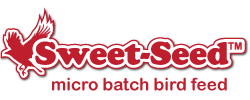Why Are There Woodpeckers at My Hummingbird Feeder!?

Hummingbirds aren't the only birds that love nectar, and many other species may also sample sips from your hummingbird feeders. Some species even have such a love for nectar's sugary sweetness that they may become regular visitors. But who are they, and how do you ensure your hummingbirds aren't going hungry?
Why Other Birds Visit Nectar Feeders
Hummingbirds may be the birds most commonly associated with nectar feeders and there's no denying that their needle-like bills are specialized for drinking nectar, but they're not alone in their drinking habits. Other birds also drink nectar, or may visit nectar feeders out of curiosity when there are many hummingbirds taking advantage of the treat. Some birds might also mistakenly perch on a nectar feeder without much intention of sipping, or they may be more interested in insects around the feeder rather than the nectar itself. In some cases, birds have even been seen to drink from water-filled ant moats attached to hummingbird feeders.
In addition to all your favorite hummingbirds, you might witness any of these birds visiting nectar feeders…
- Chickadees
- Goldfinches
- House finches
- Orioles
- Warblers
- Woodpeckers
Whether these non-hummingbirds become regular guests at your nectar feeders or not will depend on how accessible the nectar is and what other food sources are available.
Wait, That's Not a Bird…
Some hummingbird feeders can become feeding hotspots for more than just birds. Wildlife that often comes to nectar feeders includes…
- Bats
- Bears
- Butterflies
- Insects
- Lizards
- Raccoons
- Squirrels
When this type of unexpected wildlife begins to frequent a nectar feeder, it is best to take steps to discourage them. Unwanted attention from other wildlife can quickly damage or drain a feeder, and hummingbirds are less likely to visit.
Keeping Hummingbird Feeders for Hummingbirds
Whether it is unwanted wildlife or non-hummingbird birds that have taken over a nectar feeder, there are easy ways to keep hummingbird feeders for hummingbirds without harming any sweet-toothed sippers.
- Accommodate Their Needs : If you want to continue feeding other nectar lovers such as orioles or butterflies, invest in specific feeders they will like more than hummingbird feeders. Oriole feeders are generally larger and have perches for these bigger birds, and may have space for jelly or orange halves as well. An old branch can be an easy butterfly feeder when topped with a fermenting mash of banana and fruit juice these fluttering jewels will love. With better options available, orioles and butterflies are more likely to leave hummingbird feeders alone.
- Take Feeders Inside: Many unwanted nectar raiders such as bears, raccoons and bats – all of which have hearty appetites – are primarily nocturnal and will likely visit feeders overnight rather than in full daylight. Hummingbirds, on the other hand, roost at night and won't miss meals if the feeders are removed from dusk to dawn. Store feeders in a sturdy shed or closed garage to keep them out of reach of unwanted visitors, and be sure to put them out early the next day for hummingbirds to have breakfast.
- Remove Perches or Change Feeder Size: The largest nectar feeders may feed many hummingbirds, but they also feed many other birds and wildlife at the same time. Switching to smaller feeders without perches won't deter hummingbirds – many of which hover to feed anyway – but will make the nectar less accessible to other interested sippers. Feeders with smaller feeding ports are also fine for hummingbirds but less accessible to other birds and wildlife.
- Add More Feeding Stations : If all nectar-sippers are welcome in your yard, you can accommodate a range of dietary preferences and feeding styles by adding even more nectar feeders to the yard. Experiment with different feeder styles and sizes to see which are the most popular, and enjoy the company of all your nectar-loving guests. At the same time, increase the diversity of other foods in your yard – suet, mealworms, birdseed, nuts, etc. – to entice birds to try more foods they may like even better.
Nectar feeders are a mainstay in any hummingbird-friendly yard, and they can be a great treat for many birds and creatures other than just hummingbirds. By understanding what other wildlife is interested in and how to meet their needs without depriving hummingbirds of a meal, you can make your yard even friendlier for all its visitors.
